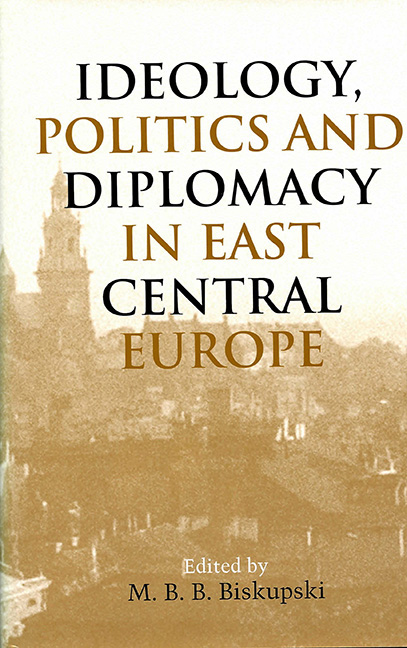Book contents
- Frontmatter
- Contents
- Preface
- Tabula Honoraria
- Piotr Wandycz
- Piotr Wandycz: An Appreciation
- 1 A Comparison of Czech Politics in Bohemia with Czech Politics in Moravia, 1860–1914
- 2 Strategy, Politics, and Suffering: The Wartime Relief of Belgium, Serbia, and Poland, 1914–1918
- 3 “This Troublesome Question”: The United States and the “Polish Pogroms” of 1918–1919
- 4 The Socialist Imprint on International Relations in Interwar Europe
- 5 Hungarian Americans during World War II: Their Role in Defending Hungary's Interests
- 6 The Nazi-Soviet Pact of August 23, 1939: When Did Stalin Decide to Align with Hitler, and Was Poland the Culprit?
- 7 Poland, the GDR, and the “Ulbricht Doctrine”
- Writings of Piotr S. Wandycz
- Contributors
- Index
1 - A Comparison of Czech Politics in Bohemia with Czech Politics in Moravia, 1860–1914
Published online by Cambridge University Press: 11 May 2017
- Frontmatter
- Contents
- Preface
- Tabula Honoraria
- Piotr Wandycz
- Piotr Wandycz: An Appreciation
- 1 A Comparison of Czech Politics in Bohemia with Czech Politics in Moravia, 1860–1914
- 2 Strategy, Politics, and Suffering: The Wartime Relief of Belgium, Serbia, and Poland, 1914–1918
- 3 “This Troublesome Question”: The United States and the “Polish Pogroms” of 1918–1919
- 4 The Socialist Imprint on International Relations in Interwar Europe
- 5 Hungarian Americans during World War II: Their Role in Defending Hungary's Interests
- 6 The Nazi-Soviet Pact of August 23, 1939: When Did Stalin Decide to Align with Hitler, and Was Poland the Culprit?
- 7 Poland, the GDR, and the “Ulbricht Doctrine”
- Writings of Piotr S. Wandycz
- Contributors
- Index
Summary
During the late nineteenth and early twentieth centuries, Czech political parties and programs in Moravia developed in many respects differently from those in Bohemia, despite much similarity in the objectives and tactics of like-minded parties in both of these Habsburg crown lands. This essay is based on two premises: first, that these differences partially reflect the somewhat dissimilar histories, economies, religious traditions, and popular cultures of the two largest Czech crown lands, and second, that a critical comparison of the same differences will facilitate historians’ efforts to understand the making of the modern Czech nation.
Most histories of the Czech people have understandably concentrated primarily upon developments in more populous and economically advanced Bohemia as opposed to Moravia. Seldom have such histories compared similar situations and events in both crown lands even though late nineteenth century politicians and journalists occasionally made such comparisons in trying to understand the pace and direction of nationwide political, economic and social change. Several of these observers even anticipated the speed and extent to which Moravian Czechs would become an integral, yet in some respects distinct, part of the modern Czech nation. The author's book on The Young Czech Party, 1874–1901, and the Emergence of the Multi-Party System addresses specific differences in the rate and nature of social and political change in the two largest Czech lands but does so primarily in order to reveal how such differences help explain the growth of the Young Czech Party in Bohemia from its founding in 1874 to the turn of the century and the rather different development of its affiliate, the Moravian People's Party, established in 1890. This essay further explores this topic by examining the multiparty system of Czech politics in Moravia as well as in Bohemia up to 1914. This system included the two middle class parties of the notables—the Young Czechs (1874–1914) and their, by 1901, already moribund rival, the National, or Old Czech, Party (1848–1914)—as well as four mass parties—Social Democrats, Agrarians, Christian Socials, and National Socialists—and three progressive parties of the intelligentsia: State Rights Radicals, Radical Progressives, and Realists (the People's, later Progressive Party).
This essay first examines the main developments in Czech politics from 1860 to 1914 by concentrating upon the objectives, tactics, and constituencies of Czech political parties and related institutions.
- Type
- Chapter
- Information
- Publisher: Boydell & BrewerPrint publication year: 2003

